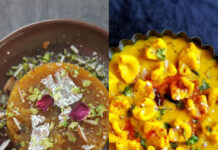Long before modern zero-waste movements found their footing in India, regional styles of cooking embraced a tradition of thriftiness, using vegetable and fruit peels, or meat scraps in various preparations.
In 1973, the cookbook author Aroona Reejhsinghani asked homecooks to take a good, hard look inside their garbage bins. In her book, Tasty Dishes from Waste Items, she lamented on people’s propensity to throw away “peels and rinds of vegetables, top leaves of vegetables, prawn shells and heads and tails of fish like pomfret… which in reality contain many valuable vitamins and minerals.”
Long before modern zero-waste movements found their footing in India, regional styles of cooking embraced a tradition of thriftiness, using every bit of a vegetable, fruit or animal in various preparations. Banana skins were chopped and sauteed, sliced bottle gourd skins were made into thogayals, and watermelon rinds were cooked in thick gravies, turned into dosas or pickled for later use.
However, it’s still common for vegetable and meat scraps to be discarded, especially in urban households. According to the Food Waste Index Report 2021, 50 kilograms of household food waste is generated per person per year in India. Most recipes either ask or assume you’ve peeled your apples, chopped off carrot ends or de-stalked your cauliflower, whether it’s for fear of contaminants sticking to the skin or a notion that they will hamper the overall taste and texture of a dish.
“The problem of food waste is a relatively modern one. India is an ancient civilisation and we have been prudent about food for millennia. Our parents and grandparents, too, once approached food and cooking with the same prudence. Yet, somewhere along the way, we lost sight of this ‘waste not, want not’ mentality,” Chef Thomas Zacharias wrote for the vernacular English daily.
But there’s so much more to stalks, root tops and meat bits. Shravani Abhishek, who operates the blog My Curry Veda, which showcases dishes and recipes from the state, says her grandmother would fry dosakaya seeds and mix them with salt and chili powder as a side dish, and the the raw mango pit was also added to rasam as a souring agent instead of tamarind. And next time you buy snake gourd, don’t throw away the seeds, says Uma Raghuraman, who runs the blog Masterchefmom. These seeds can be ground into a chutney or added to a tadka for raita.
“These [recipes] are passed down from our elders,” Shravani says.
In Bengali cooking, little is discarded as well, says Madhushree Roy Basu, who lives in Kolkata and writes about the state’s cuisine for her blog Pikturenama. The fish head and entrails are used for dals and curries, and potato peels are fried with poppy seeds to make aloo khosha bhaja. During the lockdown, Madhushree says she was cooking for eight people every day, so frugality was a necessity. “It really comes in handy when you have a large family.”
Another common way to use scraps is pickling. Usha’s Pickle Digest, with over 1000 recipes, has an entire chapter dedicated to “anti-waste” — involving everything from sour mango skins to cauliflower stems and raw plantain skin in pickles.
In Tasty Dishes from Waste Items, which features over 200 recipes, Reejhsinghani instructs homecooks to turn banana peels into kofta curries and vadas and simmer radish tops in dals. “You will see for yourself, how many valuable vitamins you are throwing away daily due to your ignorance,” she writes.
Here are 10 recipes using meat scraps, fruit and vegetables peels to try at home:
Chamakura kadala pappu (Dal with colocasia leaf stalks)
This recipe makes use of the stalks and leaves of colocasia or taro. The chopped greens are first pressure cooked along with soaked toor dal and then tempered with mustard seeds, turmeric, jeera and whole red chilli, Shravani writes.
Orange peel gojju
Orange peels hold a bright, citrusy flavour and fragrance, and are commonly used to make teas, baked goods and even rasam. This recipe from Karnataka uses the washed peels — remove some of the white interior skin to avoid bitterness — to make a spicy side dish.
Bachali aaku kadala thokku (Malabar spinach stalk thokku)
Shravani notes that malabar spinach stalks are generally discarded because of their stickiness but a quick chutney can be made with the stalks after they are pan fried to make them tender.
Peerkangai thol chutney (Ridge gourd skin chutney)
Preparations with ridge gourd peels are common across south India, and this recipe from Masterchefmom turns the skins into a simple chutney with red chillies, coconut and tamarind. The peels must first be lightly fried to make them tender.
Kalingana polo (Watermelon rind dosa)
Dosa batter is made using the thick, green rind of the watermelon, a traditional preparation from coastal Karnataka. The rind may need to be steamed and softened before it can be ground for the batter.
Banana peel vada
This recipe from Tasty Dishes from Waste Items uses the peels of four ripe bananas, along with beaten curd, jeera powder, green chillies, gram flour and coriander leaves. Remove the coarse outer fibre from the peels and soak in salted water for an hour, before draining and grinding into a paste. Mix the ingredients together along with salt, chilli powder, sugar and ginger. Form into small vadas and fry.
Macher muro diye dal (Daal with fish head)
Just like prawn tails and heads, the fish head is packed with flavour. This moong dal preparation from Pikturenama is just one of many that makes use of every part of the fish in Bengali cooking.
Spiced jackfruit seed pickle
The jackfruit seeds are steamed with salt and cut into thin pieces before it is mixed with chili powder, salt and oil in a jar. Sun the spiced jackfruit for a week. On the eighth day, blend the mixture with coriander and mustard powder. It will be ready to eat after a week and will last for two months, according to Usha’s Pickle Digest.
Prawn shell curry
From Tasty Dishes from Waste Items, Peppercorns, garlic, dry coconut and poppy seeds are fried and ground into a paste. Separately, fry chopped onions until soft and add the ground masala, followed by salt, chilli powder and turmeric powder and half-a-kilogram of prawn shells. Add tamarind pulp and slow-cook for 20 minutes.
Sour mango skin pickle
Chopped mango skins are boiled until tender, then cooked with chilli powder, jaggery, salt, ginger and vinegar, in this recipe from Usha’s Pickle Digest. Continue to cook on low heat until the jaggery dissolves and reaches a one-string consistency. Let sit for three days before eating. #livehyd







